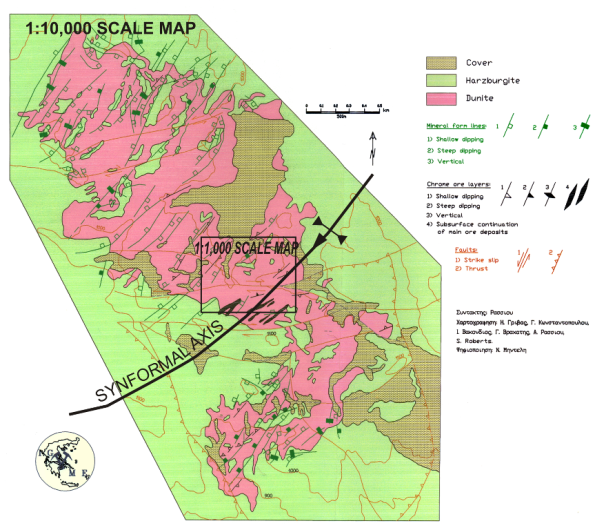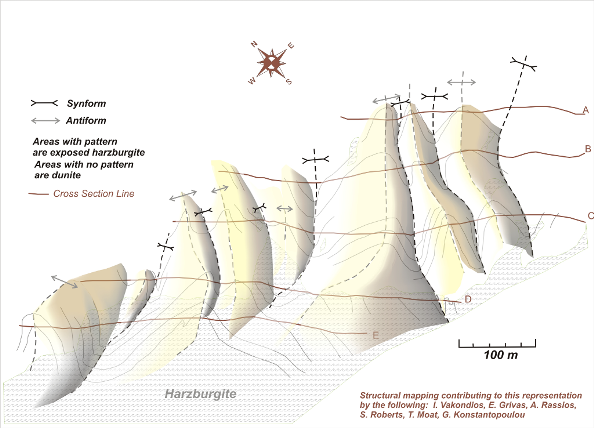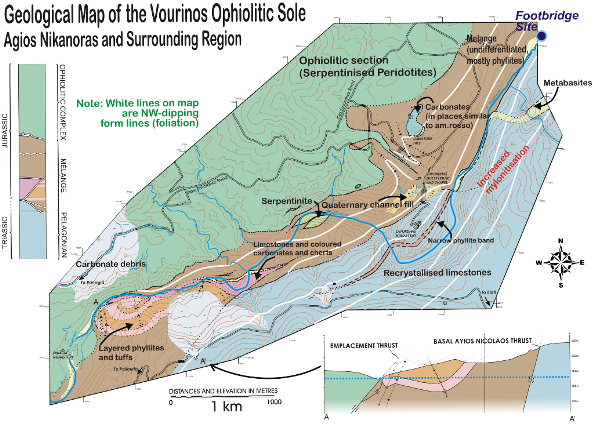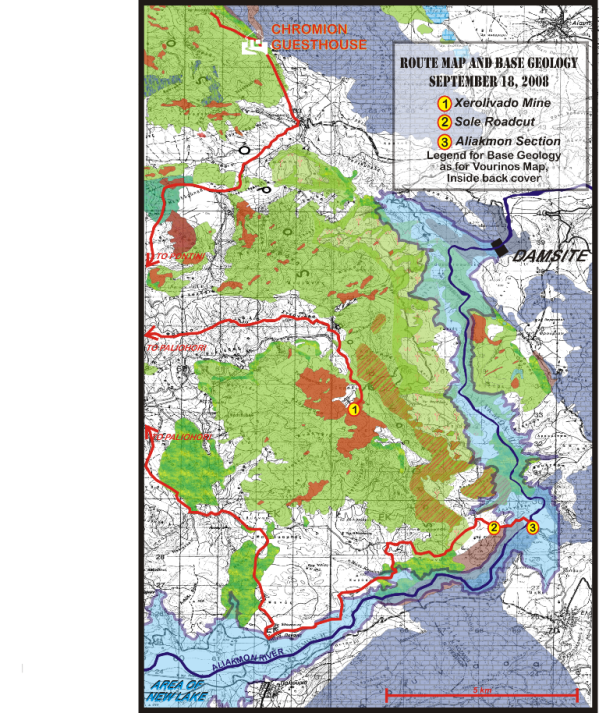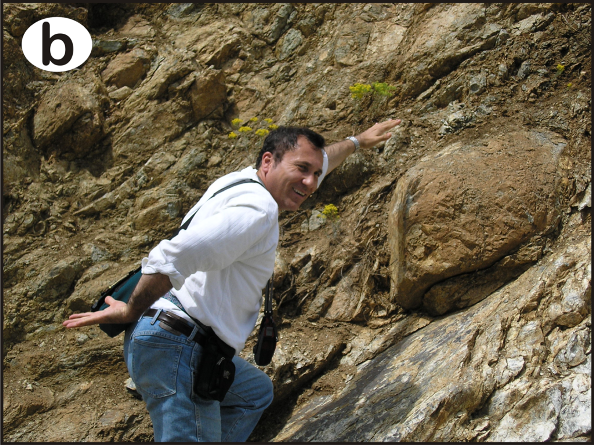Day 4 -THE VOURINOS OPHIOLITE
Traverse crossing Mantle and Sole
From the central area of Vourinos towards the SE, mantle fabrics rotate from NW with SW dip, to NE with steep dip (figure below); these form lines parallel the basal morphology of the ophiolite itself, implying a developmental relation between the turned orientation of ductile mantle fabric with that of emplacement. In a ductile nappe model, this would be predicted to reconcile lateral shear along the nappe margin.
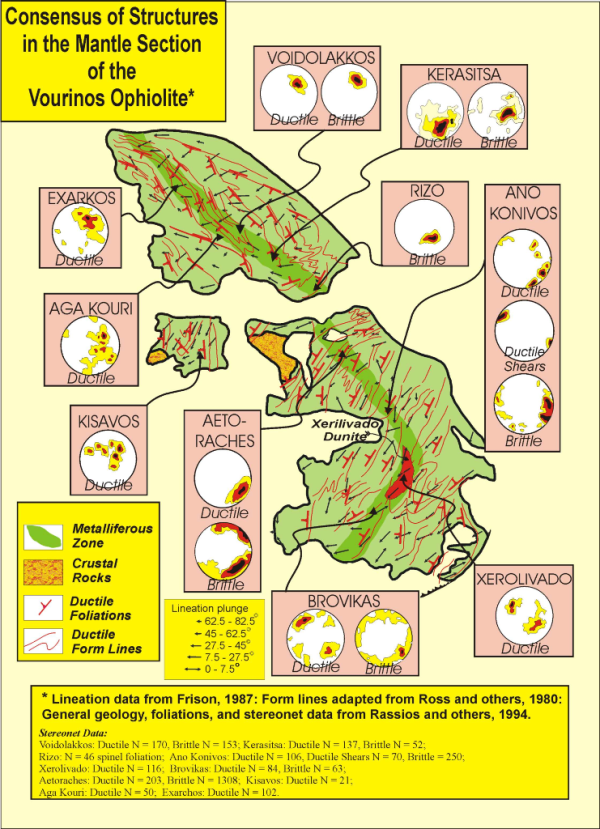
Structural analyses of the mantle peridotite of the Vourinos Ophiolite. Stereonet analyses document fabrics of individual ore districts.
Near the old entrance to the Xerolivado underground mine (now inaccessible), an open trench exposes NE-striking schlieren chrome ores in dunite. The mine operated from ~1954 until 1991, producing 2.25 mt of ore before closure due to a fall in Cr-ore prices. Despite the presence of 2.5 mt of estimated reserves, their depth complicates renewed exploitation. The ore within the trench site was sub-economic, and is not continuous to the major subsurface ore bodies. It is, however, characteristic of the morphology and geometry of “Xerolivado-type” ores. While outcrop layering suggests planar forms of the ores, they are better modeled as elongate, “snakey” shapes.
The host dunite crops out over a 3.5 x 1.5 km area that strikes ~NW and dips 10°-15° SW, continuing in the subsurface up to 10 km SW of the mine area. The dunite body has an unsymmetrical synformal shape, the axis trending NE with SE shallow plunge. The contact of the dunite with regional harzburgite is infolded, with parasitic fold axes on a wavelength of 10 – 50 m. Mineral foliations in dunite and harzburgite are parallel and define pervasive fold planes and axes. Chrome ores display small parasitic folds. Ore bodies coincide with synformal axes, with the largest bodies in the major synformal shape of the host dunite body. A morphological construction of this folding pattern defines probable sheath folds dating from late emplacement tectonism.
Remant ductile structures (orthopyroxene and spinel foliation, folded spinel bands) in serpentinised harzburgite immediately below the exposed sole on the Zavordas road are strongly imprinted by parallel brittle fabrics. These also parallel the orientation of the sole itself, here a ~1 m contact of serpentine against massive black amphibolite. Pebbly mudstone beneath the sole decreases from amphibolite-facies to phyllitic over a ~20m distance. Deformation of pebbles also decreases over this interval. Strong brittle ramping and duplex structures remain pervasive. Topping directions of all structures are NE.
The sole is tectonically disrupted by ductile and brittle ramping structures, so that it over-rides itself along its outcrop pattern; once formed, the sole is not immune to continuing lower-temperature emplacement motion. Repetitive blocks of sole, including garnet amphibolite, crop out in the interval between the roadcut and Aliakmon River below Zavordas. The footwall, the Ayios Nikolas formation, has been dated as Jr, and certainly includes blocks of tectonically incorporated Jr ophiolitic debris (as in the Chromion Valley). All small pebbles examined to date appear to have provenance in the Pelagonian continent. The resemblance of the pebbly mudstone matrix of this formation to the Tr(?) pebbly mudstones west of Fotino questions their currently accepted ages, and suggests incorporation of a once broader mudstone unit as the matrix of a tectonic mélange formed during the emplacement of Vourinos.
The dextral rotation of ductile fabrics observed over the southern Vourinos massif continues into the formations beneath the sole. These include mylonitic limestones and sediments of the Tr-Jr platform series and another “mélange” consisting of a ~7km ribbon of magmatic rocks and oceanic sediments, 85m at its widest part. Within this ribbon, cherts, pillow lavas, sheeted dikes, diorites and metagabbros can be recognized, juxtaposed via ductile deformation on a scale varying from less than a m2 to tens of m2. No inherent original petrologic seqence seems preserved within the ribbon. Metamorphism of these rocks includes amphibolite facies, with garnets in some metagabbros. Sheeted dikes with fossil chilled margins include large epidosite masses.
Since the study of Brunn, the genetic association of this ribbon has been controversial: are these small remnants of Jr ophiolite over-ridden and incorprated into the Vourinos emplacement zone, or are they members of Pelagonian basement? Chemical analyses of lavas within this ribbon show WPB association, with the implication that these are from a rifting sequence. If so, then the Aliakmon Valley includes remnants of the birth of the Pindos Basin, plus its “demise” when emplaced onto the W Pelagonian margin.
Stop 1: Vourinos Ophiolite - Xerolivado Mine
XEROLIVADO
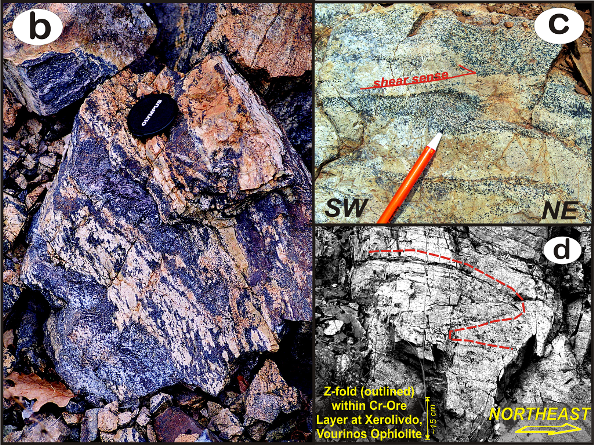
b. Ore in talus from underground mine demonstrating high-strain ductile deformation. c. NE topping kinematic indicator in ore seam. d. Dextral (NE topping) fold in ore layers above abandoned trench.
The underground chrome mine, more than 400 m beneath this site, is no longer accessible.Tailings around the old slant shaft entrance include schlieren ore, many samples of which demonstrate high-strain ductile deformation (photo b). The open trench (photo a), parallel to underground ore bodies, allows access into a subeconomic deposit of numerous ore ribbons. and displays brittle compressive structures along its walls: these allow kinematic assessment of ductile and brittle structures. Spinel foliation (photo c) parallels axial planes of parasitic folds that top to the NE, which align with regional fabric and folding. Unlike the SE-dipping structures of Doumaraki, Aetoraches and the Moho units, Xerolivado structures have been rotated 90ºCW and evidence dextral slip (as in Z-folds, photo d).
Consider: The greater apparent strain in these ores than at the near-Moho localities, and the coincidence of topping directions of ductile and brittle strain.
Stop 2: Vourinos Ophiolite - Sole Roadcut
SOLE EXPOSURE

Panorama of Vourinos Sole, or part of it anyway. Letters b through g are locations of photos below.
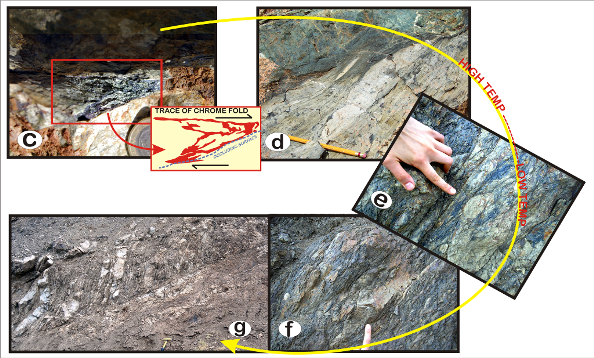
Figure c. Minor folded chromite band in serpentine immediately above the sole. This ductile deformation indicates topping relatively to the east. Figure d. Part of the sole itself: Black amphibolite over mylonitic deformed pebbly mudstone. Figure e. Greenschist facies pebbly mudstone with ductile kinematic indicators. Figure f. Ductile-brittle deformation in pebbly mudstone, lower greenschist facies with sense of topping relatively to east. Figure g. Brittle ramp in zeolitic facies pebbly mudstone topping to relative east.
Yellow arrow through photos c through g indicates relative direction of high to low temperature deformation among these localities on the roadcut.
Road building recently gave us this spectacular slice through the Vourinos sole (a). Serpentinized harzburgite to the west is emplaced over a high-temperature fault onto Ayios Nikolas Pebbly Mudstone and Triassic sediments and lavas further east. Photos along this outcrop detail specific kinematics: photo b shows NE-topping brittle imbricates in peridotite. Similar imbrication is found the length of the outcrop. Photo c is a dextral-topping, ductile-folded chrome ore band about two meters below the fault. Photo d shows constrictive movement of the massive amphibolite unit over light-colored altered and deformed footwall. Photo e shows folded pebbles and cobbles within the greenschist facies pebbly mudstone about three m east of the fault. Photo f shows phyllitic pebbly mudstone, with ductile-brittle kinematic indicators topping to the east. Photo g shows ductile to brittle ramping in the phyllitic mudstone ramping to the NE.
Consider: How representative of the sole is this particular outcrop?
Stop 3: Vourinos Ophiolite - Aliakmon Section
OPHIOLITE VS. PELAGONIAN MARGIN
Driving below the Zavordas Monastery to the site of a footbridge over the Aliakmon, the section passes beneath the sole and pebbly mudstones into the Pelagonian footwall. Along the river this inclues Tr-Jr platform carbonates to the east and along the river itself a series of Triassic carbonates, gabbros, dikes, and cherts. All are strongly imprinted by ductile deformation and metamorphosed. Garnets have been located in remnants of amphibolite sole as well as within metagabbros. Carbonates and serpentinised harzburgite caught up in this deforming zone are mylonitic. Contrasting competency among the rock types has provided a unique display of kinematic indicators.
Consider: Zimmerman included the section as part of the sole assemblage, while Brunn classified the section, as well as the amphibolite units, as part of the basement. The spilites and lava chemistry within the highly deformed zone prove to be characteristic of rifting sequences. Did the site of initial Triassic rifting of the Pelagonian provide the ready-made framework to facilitate Jurassic ophiolite ramping onto the continental margin?

Figure a. Mylonitic carbonates from Aliakmon River section. Figure b. Mylonitic carbonates demonstrating fold. Figure c. Chert and pelitic sediments of tectonic mélange demonstrating complex folding and small ductile-brittle faults.
Exposures include a varied petrologic assemblage derived from members of the Pelagonian margin sedimentary cover, oceanic sediments, lavas, dikes, and gabbros of a rifting sequence, and shards of the ophiolitic slab and sole. Deeper parts of the Pelagonian are not included, though their deformation has been shown in exploratory boreholes placed for damsite planning. All are metamorphosed to some extent varying from amphibolitic to greenschist facies, and all are highly deformed. Deformation and kinematics demonstrate brittle to high temperature ductile conditions reconciling dextral shear between Vourinos and the Pelagonian margin. The rotation of internal ophiolitic structures (as at Xerolivado) exclude emplacement of the ophiolite onto pre-existing deformation; the lack of imprinting fabric common to Pelagonian basement and Vourinos precludes the interpretation as later exhumation fabric.

Figure d. Mylonitic pebbly mudstone metasediments. Figure e. Pillow lavas and chert of rifting sequence. Figure f. Deformation of gabbro from rifting sequence.
